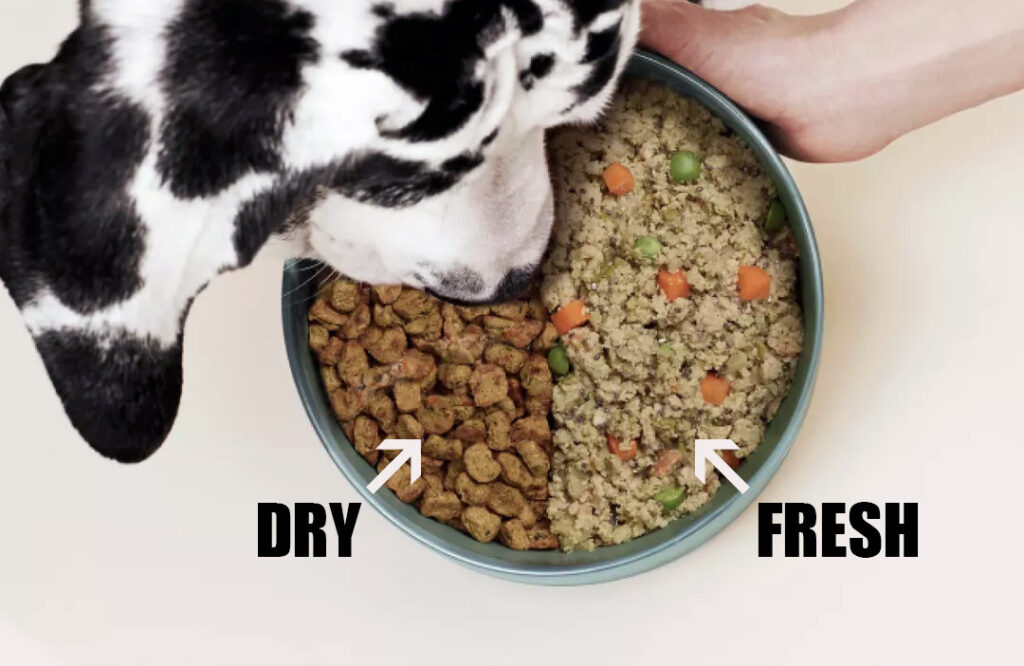Choosing the right food for your dog is important. It helps keep them healthy and happy. But there are so many options out there. You have dry food, wet food, fresh meals, and even raw or freeze-dried options. It can be overwhelming.
This guide is here to help you. We will go through each type of dog food and examine the good and the bad of each. We’ll also cover things like cost and what to look for on labels. By the end, you’ll have a clear idea of what’s best for your dog.
Types of Dog Food
Dry Dog Food
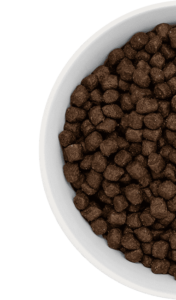
Dry dog food is the most common type you’ll find. It’s made from a mix of meats, grains, and vegetables. This type is easy to store and lasts a long time, but it can be less appetizing for some dogs.
Popular brands include Purina, Hill’s Science Diet, and Blue Buffalo. If you’re looking for cost savings, longevity, and ease of use, dry food is a good pick. Just make sure you have an airtight container for storage.
Pros:
- Long storage life
- Easy to buy in bulk
- Readily available at any pet store
- Easy to feed
- Cheapest food type
Cons:
- The most processed kind of dog food
- Some brands and mixes have subpar nutrient profiles
- Harder to get good sources of fats
- Least flavorful
Wet Dog Food
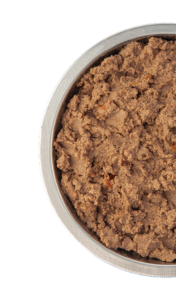
Wet dog food comes in cans or pouches. It’s moist and often more flavorful than dry food. Many dogs find it tasty, making it a good choice for picky eaters.
However, wet food can be more expensive. It also has a shorter shelf life once opened. Brands like Royal Canin and Nutro offer high-quality wet food options. Remember to refrigerate any unused portions.
Pros:
- Flavor that dogs love
- Typically more protein-dense than dry kibble
- Easily available in most pet stores
Cons:
- More expensive than kibble
- Depending on serving size, you may need to store smelly cans in your refrigerator
- Opening cans and recycling them can be more time-consuming
- Canned dog food can be heavily preserved and processed
Fresh Dog Food
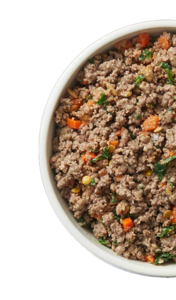
Fresh dog food is a newer trend. It offers natural meals that are closer to what humans eat. These are made of fresh ingredients and usually come refrigerated or frozen.
Something that illustrates the difference between fresh and canned dog food is that canned dog food is typically a brown slurry where everything is indistinguishable, whereas with fresh dog food, you can actually see the fresh meat and vegetables mixed together.
The upside is higher nutritional value and taste. The downside is the cost and shorter shelf life. Brands like The Farmer’s Dog and Ollie offer custom meal plans. Store these meals in the fridge or freezer.
Pros:
- Fresh flavors with no artificial preservatives and processing
- Mailed directly to your door
- Serving sizes customized for your dog
Cons:
- More expensive than other options
- Pouches need to be stored in a freezer or fridge
Freeze-Dried Dog Food
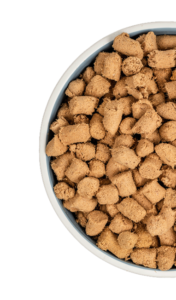
Freeze-dried dog food is dry food’s more nutrient-packed cousin. It goes through a process that removes moisture but keeps the nutrients. This makes it lightweight and easy to store.
It can be expensive but is often chosen for its high nutritional value. Stella & Chewy’s and Primal are popular brands in this category. Store this type like you would dry food, in a cool and dry place.
Pros:
- Extremely lightweight and shelf-stable
- Nutrient-dense, as all moisture has been removed
- Easy to travel with
Cons:
- Extremely expensive
- Some concerns about pathogens making it through the freeze-dry process
Raw Dog Food
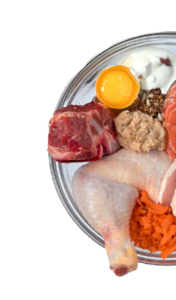
Raw dog food is exactly what it sounds like. It’s uncooked meat, often with bones, organs, fruits, and vegetables. Some owners swear by its benefits, like shinier coats and higher energy levels.
However, raw food poses risks like bacterial contamination. If you go this route, follow strict safety guidelines. Brands like Darwin’s Natural and BARF World offer safer, commercial options. Always store raw dog food in the freezer to keep it safe.
Pros:
- Closest to a dog’s “natural” diet
Cons:
- Lots of effort to buy ingredients and prepare meals
- Potential illness risk with uncooked foods
Nutritional Needs Across Life Stages
Puppies
Puppies grow fast and have specific nutritional needs. Protein is crucial for their muscle development. Calcium and phosphorus are important for bone growth. Make sure the food label says it’s formulated for puppies or for “all life stages.”
High-quality brands like Hill’s Science Diet and Royal Canin offer puppy-specific formulas. Be mindful of portion sizes and feeding frequency. Puppies usually need to eat 3 to 4 times a day.
Adult Dogs
Adult dogs don’t grow as quickly as puppies. They still need a balanced diet rich in protein, healthy fats, and fiber. A good adult dog food will also have added vitamins and minerals.
Brands like Blue Buffalo and Nutro have adult-specific formulas. Adult dogs typically eat twice a day. Portion sizes will depend on your dog’s size, breed, and activity level.
Senior Dogs
As dogs age, their metabolism slows down. Senior dogs often need fewer calories but more high-quality nutrients. They may also require more fiber to aid digestion and less fat to prevent weight gain. Look for foods labeled as “senior” or “mature.”
Brands like Purina Pro Plan offer formulas for older dogs. Always consult your vet for advice, especially if your senior dog has health issues. Feeding frequency for seniors is generally twice a day, but portions may be smaller.
By understanding the different nutritional needs at each life stage, you can choose the right food for your dog. Always read labels carefully and consult your vet for any specific concerns or dietary adjustments.
Dietary Needs by Size, Breed, and Activity Level
Small Breeds vs. Large Breeds
Small and large breeds have different nutritional needs. Small breeds often require food that’s higher in calories and nutrients. This is because they have faster metabolisms. Brands like Wellness CORE and Royal Canin make small-breed specific formulas.
Large breeds, on the other hand, can be prone to joint issues. They may benefit from food that includes joint-supporting nutrients like glucosamine and chondroitin. Look for brands like Nutro Ultra and Eukanuba that offer large-breed formulas.
Active vs. Less Active Dogs
Activity level also plays a big role in nutrition. Highly active dogs need more calories, protein, and certain fats. They can benefit from performance or active formulas that offer sustained energy. Brands like Purina Pro Plan Sport are designed for active dogs.
Less active dogs need fewer calories to prevent weight gain. However, they still need a balanced diet. Look for foods that are lower in fat but still high in essential nutrients. Brands like Hill’s Science Diet offer “light” options.
Understanding your dog’s size, breed, and activity level will help you select the most appropriate food. Tailoring your choice to these factors ensures that your dog receives the optimal mix of nutrients for a healthy life.
Special Dietary Needs and Health Conditions
Obesity
If your dog is overweight, reducing calorie intake is crucial. Foods labeled as “weight management” or “light” are formulated with fewer calories. They also often have higher fiber content to make your dog feel fuller.
Brands like Blue Buffalo and Hill’s Science Diet offer weight management options. Always consult your vet before starting your dog on a weight-loss regimen.
Diabetes
Dogs with diabetes need a diet that helps regulate blood sugar levels. Foods high in fiber and complex carbohydrates are ideal. This helps slow the absorption of sugar.
Brands like Royal Canin and Orijen offer diabetic-friendly formulas. A vet’s guidance is essential for managing diabetes through diet.
Allergies
Food allergies in dogs can manifest as skin irritations, digestive issues, or respiratory problems. The usual culprits are beef, chicken, eggs, corn, wheat, soy, and milk.
Hypoallergenic dog foods are available from brands like Nutro and Natural Balance. These foods often use novel proteins like venison or duck to reduce allergic reactions. A vet can help diagnose and recommend appropriate foods for allergies.
Sensitive Stomach
Some dogs have sensitive stomachs and need foods that are easy to digest. Look for foods with simple ingredients and fewer additives.
Brands like Canidae and Wellness offer sensitive stomach formulas. They typically feature straightforward proteins and easy-to-digest carbs.
Understanding Dog Food Labels
Key Things to Look For
When you pick up a bag or can of dog food, the first thing to check is the list of ingredients. They’re listed by weight, so the first ingredient is what the food contains the most. Look for a named animal protein as the first ingredient, like “chicken” or “beef,” rather than vague terms like “meat” or “animal by-products.”
Also, look for the AAFCO (Association of American Feed Control Officials) statement. This tells you if the food meets basic nutritional guidelines. It will specify if the food is appropriate for a particular life stage, such as “adult maintenance” or “growth and reproduction.”
Interpreting Nutritional Information
You’ll also see a “Guaranteed Analysis” section on the label. This shows the minimum or maximum amounts of nutrients like protein, fat, fiber, and moisture. Keep in mind that the figures are general guidelines. The actual nutrient values can vary.
For example, if the label says “minimum 24% protein,” the actual content could be higher. Comparing these percentages across different types of dog food (dry, wet, etc.) can be tricky because moisture content affects these values. View our complete guide on how to read dog food labels to be an expert in no time.
Additives and Preservatives
Be cautious about additives and preservatives. Natural preservatives like tocopherols (Vitamin E) are generally better than artificial ones like BHA and BHT. Also, be wary of food colorings and unnecessary fillers like corn syrup or cellulose.
Understanding how to read dog food labels can help you make an informed choice about your pet’s nutrition. Knowing what to look for and how to interpret the information ensures that you are providing a balanced diet suitable for your dog’s age, size, and health condition.
Cost Comparison
Tufts analyzed the price of different dog food types and found estimates of the daily costs to feed a 55lb dog. In their study, they opted to analyze freeze-dried food under the “raw” category because they do not endorse feeding raw food.
A rough estimate to feed fully raw food is $10-15 per day but can vary widely depending on the quality of ingredients.
| Dry | Wet | Fresh | Freeze-Dried | Raw |
|---|---|---|---|---|
| ~$0.55 – $2.42 | ~$2.97 – $9.02 | ~$9.81 – $14.89 | ~$17.50 – $19.80 | ~$10 – 15 |
Balancing Cost and Nutrition
Price should not be the sole determining factor when choosing dog food. Nutritional value is crucial. Sometimes, spending a bit more upfront can save you on veterinary bills later. Always balance the cost with your dog’s specific nutritional needs, life stage, and any special health considerations.
Understanding the cost involved in your dog’s food choice is essential. It’s not just about saving money; it’s about providing your dog with the best nutrition within your budget. Always weigh the pros and cons and consult with a veterinarian to make the most informed choice.
How to Transition from One Type of Dog Food to Another
Gradual Change
Switching your dog’s food suddenly can cause digestive upset. It’s recommended to make the change gradually over a period of 7 to 10 days. Start by mixing a small amount of the new food with the old. Gradually increase the ratio of new to old each day.
Monitor for Reactions
During the transition period, keep an eye out for any signs of food allergies or sensitivities. This can include itching, digestive issues, or changes in energy levels. If you notice any adverse reactions, consult your vet immediately.
Scheduled Feeding Times
Consistency helps when changing diets. Keep feeding times regular. This not only aids in the transition but also helps in monitoring for any changes in appetite or digestion.
Consult Your Vet
If your dog has special dietary needs or health conditions, it’s crucial to consult your vet before making any significant changes to their diet. Your vet can provide guidance on what type of food would be most appropriate and how best to transition your dog onto it.
Changing your dog’s diet is not something to be done on a whim. It requires careful planning and observation. A successful transition to a new type of dog food can lead to improved health, better quality of life, and potentially even cost savings in the long term. Follow these tips and consult your vet to ensure a smooth changeover.

